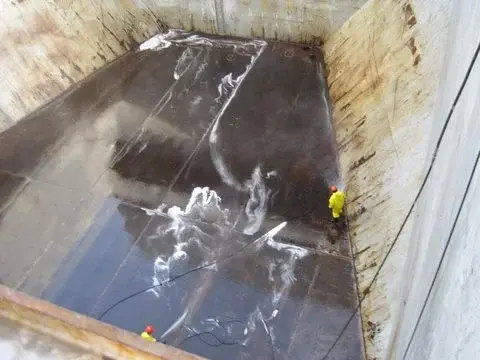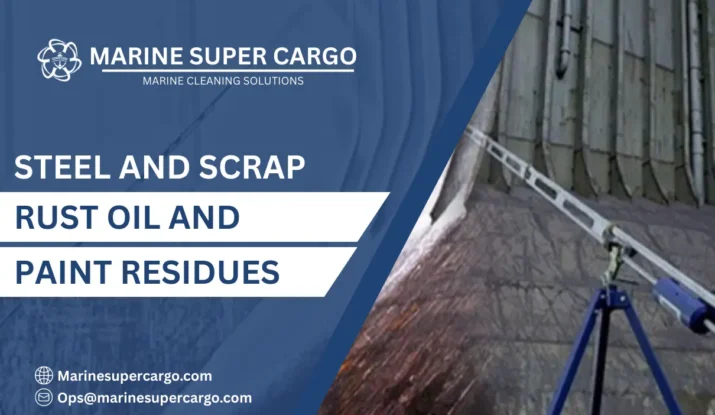Steel and scrap rust oil and paint residues present complex contamination challenges in bulk carrier operations worldwide. These mixed contaminants create persistent deposits that combine corrosive compounds with hydrocarbon contamination throughout cargo spaces. Understanding the multifaceted nature of steel and scrap rust oil and paint residues is essential for maintaining vessel cleanliness and ensuring regulatory compliance.
The transportation of steel and scrap materials generates diverse residues including rust particles, lubricating oils, and paint flakes that accumulate throughout cargo hold structures. Steel and scrap rust oil and paint residues create cleaning complexities that require specialized approaches addressing both organic and inorganic contamination simultaneously. These materials leave distinctive staining patterns on bulkheads and tank tops.
Understanding Steel and Scrap Contamination Characteristics
Steel and scrap rust oil and paint residues exhibit unique combination properties that complicate standard cleaning procedures. Iron oxide particles create abrasive conditions that can damage protective coatings, while hydrocarbon compounds penetrate porous surfaces and create persistent odors throughout cargo spaces.
Oil contamination from steel and scrap rust oil and paint residues creates fire hazards and environmental risks requiring specialized handling protocols. These organic compounds combine with metal particles to form adhesive deposits that bond strongly to vessel structures. Forward holds near the forecastle often experience more severe contamination due to condensation mixing with oil residues.
Paint flakes contribute toxic compounds that require careful disposal procedures. Steel and scrap rust oil and paint residues create environments where multiple cleaning approaches must be coordinated to address each contamination type effectively. Professional assessment determines appropriate removal strategies for complex mixed contamination.
MARPOL and IMO Environmental Protection Framework
The International Maritime Organization (IMO) establishes comprehensive guidelines for managing mixed cargo residues and environmental protection requirements. MARPOL Annex I specifically addresses oil pollution prevention, while Annex V covers solid waste management for steel and scrap rust oil and paint residues operations.
Steel and scrap rust oil and paint residues cleaning must comply with international standards for both hydrocarbon and solid waste disposal. All cleaning residues containing oil compounds require proper containment and certified disposal methods. The IMO mandates detailed documentation of cleaning procedures and waste segregation protocols.
Environmental protection regulations under MARPOL require careful management of oily cleaning wastewater and contaminated solid residues. Vessel operators must ensure compliance with discharge regulations while maintaining accurate records of all activities involving steel and scrap rust oil and paint residues.

Professional Cleaning Solutions by Marine Super Cargo
Marine Super Cargo specializes in addressing steel and scrap rust oil and paint residues through integrated cleaning methodologies designed for mixed contamination scenarios. Our experienced teams understand the complex challenges posed by combined organic and inorganic deposits and employ comprehensive removal techniques.
Our systematic approach includes thorough assessment of contamination types throughout cargo spaces. We utilize specialized degreasing agents combined with abrasive removal systems designed for eliminating rust particles and paint residues. Steel and scrap rust oil and paint residues removal requires careful coordination between chemical and mechanical cleaning phases.
Marine Super Cargo employs advanced waste segregation systems that separate oil-contaminated residues from solid metal particles during cleaning operations. Our teams work methodically through vessel spaces from tank tops to bilge areas, ensuring complete removal of all steel and scrap rust oil and paint residues while maintaining environmental compliance.
Technical Challenges and Integrated Solutions
Bulk carriers face multiple complications when dealing with steel and scrap rust oil and paint residues. Oil contamination creates fire hazards requiring specialized safety protocols, while abrasive metal particles can damage cleaning equipment and protective coatings. The combination of different contamination types requires multiple cleaning approaches.
Port-side and starboard holds often display different deposit patterns due to cargo settling and oil migration during transport. Aft sections near the stern may experience concentrated oil contamination in areas with restricted ventilation. Forward holds require particular attention to remove rust particles that accumulate in structural recesses and drainage systems.
Professional cleaning services address these challenges through multi-phase removal protocols. Initial oil recovery removes hydrocarbon contamination, followed by mechanical cleaning that eliminates rust particles and paint flakes. Final degreasing ensures complete removal of all steel and scrap rust oil and paint residues traces.
Prevention and Risk Management Strategies
Preventing excessive steel and scrap rust oil and paint residues formation begins with proper cargo preparation and handling procedures. Ensuring adequate drainage systems prevents oil accumulation while proper ventilation reduces condensation that accelerates rust formation. Regular monitoring during cargo operations enables early intervention when contamination levels increase.
Crew training plays a crucial role in managing steel and scrap cargoes safely. Understanding the characteristics of steel and scrap rust oil and paint residues helps crews implement appropriate containment measures during loading and discharge operations. Proper fire prevention protocols ensure safe handling of oil-contaminated materials.
Marine Super Cargo provides comprehensive prevention programs designed to minimize contamination risks. Our services include drainage system maintenance, fire safety protocols, and crew training programs focused on mixed cargo handling best practices.
Industry Standards and Safety Requirements
Maritime industry standards for handling steel and scrap rust oil and paint residues continue evolving with improved safety technologies and environmental protection measures. Modern bulk carriers incorporate enhanced oil containment systems and fire suppression capabilities. These innovations help reduce contamination risks and improve operational safety.
Cleaning protocols must balance thorough contamination removal with safety requirements for handling mixed hazardous materials. Proper waste segregation ensures compliance with steel and scrap rust oil and paint residues disposal regulations while maintaining operational efficiency. Quality control measures verify complete contamination removal before cargo hold certification.
International safety standards require coordination between ship operators, cleaning contractors, and environmental authorities. Marine Super Cargo facilitates this coordination through comprehensive service packages that ensure regulatory compliance and operational excellence.
Environmental and Safety Considerations
Modern cleaning approaches for steel and scrap rust oil and paint residues emphasize environmental responsibility and worker safety. Oil recovery systems minimize hydrocarbon waste while ensuring effective contamination removal. Personal protective equipment protects personnel from exposure to toxic paint compounds during cleaning operations.
Waste treatment protocols ensure proper handling of mixed contamination types according to international disposal regulations. These approaches align with MARPOL environmental protection objectives while maintaining safety standards throughout steel and scrap rust oil and paint residues removal operations.
Fire prevention measures remain critical throughout cleaning operations involving hydrocarbon contamination. Specialized ventilation systems prevent vapor accumulation while ensuring thorough contamination removal from all affected areas.
Frequently Asked Questions
Q1: What safety hazards are associated with steel and scrap residue cleaning?
A: Fire risks from oil contamination, respiratory hazards from paint particles, and injury risks from sharp metal fragments require comprehensive safety protocols and protective equipment.
Q2: How are different contamination types separated during cleaning?
A: Professional waste segregation systems separate oily residues from solid metal particles, ensuring proper disposal according to different regulatory requirements for each waste type.
Q3: What cleaning methods effectively remove combined oil and rust contamination?
A: Sequential cleaning using oil recovery systems, degreasing agents, and mechanical removal techniques provides comprehensive elimination of mixed contamination types.
Q4: What MARPOL requirements apply to mixed contamination waste disposal?
A: Oily residues fall under Annex I requirements while solid waste follows Annex V protocols, with all materials requiring certified disposal facilities and proper documentation.
Q5: Can mixed contamination affect subsequent cargo compatibility?
A: Yes, residual oil and metal particles can contaminate sensitive cargoes, making thorough cleaning essential for maintaining cargo hold versatility and charter flexibility.
For professional bulk carrier hold cleaning services specializing in mixed contamination scenarios, contact Marine Super Cargo today. Our expert teams ensure complete residue removal while maintaining MARPOL compliance and operational safety standards.


